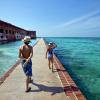Florida Culture: Ethnic and Cultural Footprints Across the State
By Chelle Koster Walton
Greeks, Spaniards, Cubans and Native Americans, among others, have left their cultural footprints at these historic Florida cities and towns.
We're one better than a melting pot. Cultures don't dissolve into one another here in Florida. They remain whole, creating a collage of ethnicity that represents the global community, with special emphasis on tropical latitudes and seaworthy heritage.
And so it has become a land of fiery foods, sizzling music, salty temperament, colorful accents, striking architecture, and passionate arts. You will experience the diversity and influences in practically every city and town in the state, but in certain places different cultures have stamped a mark that persists in preserving a way of life carved from distant, exotic places. Experience Florida's cultural diversity across the state.
North Florida
St. Augustine
Florida's tradition for welcoming visitors from afar began here and in historic Pensacola, Florida's oldest cities. Well, to be truthful, our tribes didn't exactly welcome the early Spanish conquistadores who contributed the first influx of European heritage, but the Spanish influence has persisted nonetheless. Spain ruled this settlement even longer than the U.S.A. has.
The Spaniards left for 20 years when Britain ruled, fleeing to Cuba then returning with an injection of Latin fire. Mixed in with Spanish architecture and temperament are other strains that make St. Augustine the multi-patterned quilt it is today. Greeks, Minorcans and Africans also spiced the pot. Nearby Fort Moses, settled by runaway slaves from Georgia and the Carolinas, was America's first black settlement. Later, African-Americans built a lovely Victorian neighborhood called Lincolnville, still vital and easily accessible from the downtown historic district.
Central Florida
Orlando/Eatonville
The first community ruled by African-Americans, Eatonville was also home to noted Black Harlem author and folklorist Zora Neale Hurston. Today the once neighboring town of Orlando envelopes the community and its historic sites.
Back then, Zora's parents and other adult citizens would travel to Parramore, Orlando's segregated community, where black professionals lived and came for entertainment. The South Street Casino hosted Count Basie, Duke Ellington and other notables, who boarded next door at the Wells' Built Hotel. The hotel today holds a museum that chronicles the heydays and in the surrounding community, festivals, restaurants and artisan shops celebrate the African-American spirit. Contact: Visit Orlando at visitorlando.com.
Tarpon Springs
Greek divers came here to harvest sponge 100 years ago. The sponging industry continues to draw swarthy seamen and their families, making the neighborhood around the sponge docks a living museum. Dodecanese Boulevard smacks the senses with the aroma of fresh-baked Greek pastries, the chatter of the mother tongue, the busyness of the marketplace, and the salty scent of curing sponges.
The sponge markets and Greek restaurants are easily accessible to visitors, who may also experience a deeper sense of the culture at services in St. Nicholas Greek Orthodox Cathedral, site of the annual Epiphany festivities in January. Contact: St. Petersburg/Clearwater Area Convention & Visitors Bureau.
South Florida
Delray Beach
Tour the town's 1.3-mile Cultural Loop for a sampling of the African-American, Japanese, Haitian and Bahamian cultures that have shaped the town. Street sculptures along the Loop's Pineapple Grove ArtWalk celebrate Delray Beach's diverse cultures and historic sites memorialize racial segregation and civil rights movements.
Key West
The Cubans immigrated first to this easily accessible island only 90 miles away to flee early oppression and revolution and to transplant their cigar factories. Their influence survives in architecture, art and cuisine, showcased at the San Carlos Institute.
Miami
Another living museum of culture, Miami has welcomed peoples of many origins to its safe haven and land of opportunity, most notably Cuban refugees. Their influence is city-wide, mingling with other Latin and Caribbean cultures to create a spicy stew of arts. Along Calle Ocho, Eighth Street, so-called Little Havana's main thoroughfare, salsa music, the slap of dominoes, and strong café con leche transport visitors to a different place, a different time.
Seminole and Miccosukee communities
The first Americans have since disappeared from South Florida, but other Amerindian cultures later moved in from North Florida and surrounding states and, threatened by removal and war, established communities throughout southern Florida. Many of the Seminole and Miccosukee tribes were forced into the raw wilderness of the Everglades, where today they welcome visitors to experience their nature-bound way-of-life.
Ybor City
Another Cuban settlement during the early cigar-making glory days, this Tampa neighborhood remembers its roots with Latin restaurants, period architecture, lively street festivals and traditional coffee-roasting and cigar-rolling industries.



























